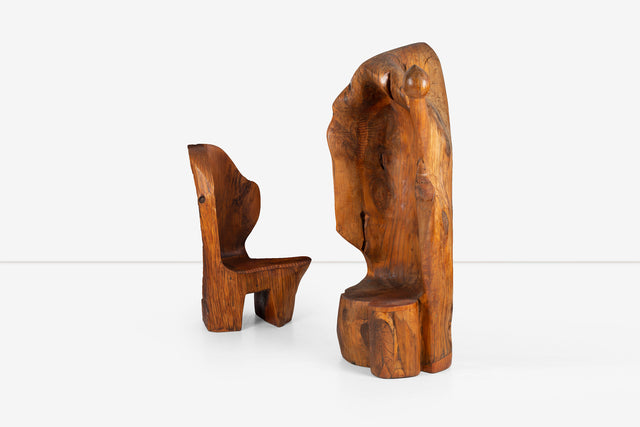Salon Art+Design 2022: With a Continent Between to Be Free
Nov 07, 2022by Michael Graham
CONVERSO returns to Salon Art + Design with rare works by the legendary renegade American architect, Bruce Goff, the one and only architect Frank Lloyd Wright admitted admiring, and JB Blunk, protege to Isamu Noguchi whose monumental sculpture in wood is now an emblem for an entire era of Northern California avant-garde activity. Two monumental throne chairs in cypress, sculpted by chainsaw, Blunk’s signature tool, will be on view. Converso has rediscovered the foundry proof for the dining ensemble for Shin’en Kan, Bruce Goff’s 1956 masterpiece completely lost to arson in 1996. The suite of table and chairs will be presented, anticipating the Art Institute of Chicago’s upcoming authoritative Goff exhibit in 2025. Works by George Nakashima, including an important Conoid Bench and Desk, a massive Willow chandelier by Harry Bertoia, and works by Alma Allen, Paul Evans, and the contemporary black designer, Norman Teague, recently selected to represent the United States at the Venice Biennale in Architecture, complete the presentation. The moment in 1952 when Isamu Noguchi, accompanied by his famous wife, the movie star Yoshiko Yamaguchi, noticed the young JB Blunk in uniform intently examining pottery in a Mingei shop in Tokyo was, indeed, overdetermined. Noguchi, finishing his residence with Kitaoji Rosenjin, the great tyrannical impresario of 20th C Japanese ceramics, was busily overturning the categories of Japanese pottery with the previously unknown concept of the nonfunctional ceramic sculpture. Blunk, exposed to the Mingei movement at UCLA under Laura Andresen and starving for more, now drafted into the Korean war, was more than ready to jump when Noguchi opened the golden door to the traditional pottery families and kilns of Japan, churning in the midst of a major post war ceramic revival. Blunk, after Noguchi himself, became the first American initiated into the centuries old, Kyoto centered washuko (tea ceremony) ceramic tradition, working with Rosenjin and then Kaneshige Toyo, ultimately designated a Living National Treasure. After his return to California, Blunk built his home in the woods of Inverness north of San Francisco and established a practice that moved fluidly across material and scale, from jewelry to ceramics to painting to his monumental sculptures in wood and stone.
Existing narratives surrounding Goff and Blunk tend to emphasize their peripheral, regional status in relation to a center, usually imagined as NYC and its proximate cultural institutions: Goff in Oklahoma and the greater Midwest; Blunk in Northern California. But time and the winding tendrils of influence are clarifying. In the vastness of a mid century America spanned by dense, often intertwined and nomadic international networks, both Goff and Blunk sat astride particularly rich nodes fed by important avant-garde sources.



Gordon Onslow Ford, a member of the Paris Surrealist circle who had played an important role in Surrealism’s initial reception in New York through his lectures at the New School and later founded San Francisco’s Dynaton group, was Blunk’s patron and Inverness neighbor for 40 years, introduced by Noguchi. Onslow Ford, like other Surrealists in exile, had already passed through Mexico and explored indigenous and pre Columbian American cultures, interests Blunk shared, and this was also the case with the Surrealists, Wolfgang Paalen and Roberto Matta, whom Blunk came to know through Onslow Ford, along with other figures like the musician Harry Partch and Alan Watts. Anna and Lawrence Halprin were major patrons living just on the other side of Mt. Tamalpais in Mill Valley where, before they decamped for Judson Street in NYC, Yvonne Rainer, Simone Forti, Trisha Brown, Robert Morris, and John Cage were famously improvising on the outdoor dance floor that Lawrence had built for Anna amongst the trees. Jung and associated works took up much space on Blunk’s shelf and he, Onslow Ford, and Lawrence Halpern formed an apparent Jungian group around Joseph Henderson, Jackson Pollack’s analyst, exploring mysticism and the deeper realms of the unconscious, extending the original surrealist project and providing deep roots for the project of bringing nature back across the Golden Gate Bridge to the city.
Bruce Goff remains the most astonishing and still most astonishingly unknown American architectural genius of the 20th Century, despite constant publication and a hugely productive career that left built projects scattered from Chicago to California. He claimed Gertrude Stein and Claude Debussy as aesthetic guides and composed radical pieces for player piano. Conventional categories often dissolve in the face of a Goff project. Contemporary admirers range from Frank Gehry to Peter Zumthor, who is preserving Goff’s Japanese Pavilion as part of the new master plan for LACMA. The highly respected architectural program he directed at Oklahoma University throughout the 40’s and early 50’s, before it was cut short by a Hoover Era sting targeting his sexuality, was recognized as the most original and radical program in the country, drawing students internationally. It came to be known as the American School of organic architecture.
Goff, a prodigy already apprenticed at age 12 to Tulsa’s leading architectural firm, had arrived in what was still the Indian Territory when settlers were living in sod huts. He completed his first built residential project when he was 14. Reaching towards concepts similar to those of Frank Lloyd Wright, the teenage Goff contacted him. Wright responded with an original edition of the Wasmuth Portfolio in a beautiful silk-covered box with a signed note: “Happy to know I have a friend in Tulsa, Oklahoma.” At the end of Wright's life, the two architects would continue to share ideas and even local foundry resources as they simultaneously worked on Price Tower and Shin'en Kan.




